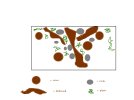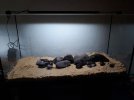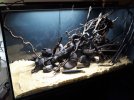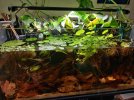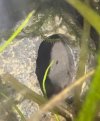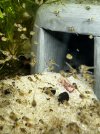Bakejullock
New Member
- Messages
- 12
Meet Sid and Nancy! Adopted these two on Saturday. They are currently living in a planted 10 gallon tank by themselves. The tank stays around 82 degrees. They have lots of hiding places and 2 caves to choose from (one of which I built myself from stone!) i’ve been feeding them live baby brine shrimp, frozen bloodworms, fluval bug bite flake and xtreme nano pellets. They are a proven pair and have successfully spawned once with the previous owner. I am hoping they can do it again in their new home!
Some observations and questions:
- I was told these are cockatoos called “orange flash”. Can anyone confirm, and maybe explain the coloration/grading system of this type of fish?
- Upon introducing them to the tank the female immediately started investigating the right side cave. She was in and out constantly, with the male following a few times. At one point the male had only his hind quarters in the cave, with his head sticking out. I watched him quiver 3 times. I was curious if he was fertilizing the eggs? Unsure if that is even how it works, or if they would spawn so quickly after being moved to a new tank.
The female has since been seemingly spending less time in the right side cave and more time in the left side cave. I assume that means she has not dropped any eggs yet? Once she has eggs to protect, she will stay in or close to the cave they are in?
- The male displayed some interesting behavior on the first day. He set up shop in the front right corner of the tank and barely left for hours. He flared his fins and used his tail and fins to blow the sand around, basically digging himself a shallow hole in the corner of the tank. I have read that digging is common post spawning behavior, but that it is usually the female doing the digging, and in front of the cave. Anyone know why he was doing this? I thought maybe to try to feel more safe and protected, but that seemed odd as he has tons of cover and hiding spots elsewhere in the tank, where he wouldn’t have my giant dumb face staring right at him.
- I assume neocaridina shrimp are a bad idea to introduce to this tank? What about small corydoras? Just curious. I realize it’s already probably too small of a tank, and I do not want to stress them out or throw a wrench in the spawning process. I read somewhere that having a few bottom feeders could be a good thing, as it gives the mother something to protect the fry from which in turn makes her more diligent and caring. Seems weird to me but does anyone have any experience?
Any tips, advice or insight would be much appreciated! My goal is to keep these two as happy as possible, and have them produce offspring and raise them up.




View attachment IMG_0898.jpeg
Some observations and questions:
- I was told these are cockatoos called “orange flash”. Can anyone confirm, and maybe explain the coloration/grading system of this type of fish?
- Upon introducing them to the tank the female immediately started investigating the right side cave. She was in and out constantly, with the male following a few times. At one point the male had only his hind quarters in the cave, with his head sticking out. I watched him quiver 3 times. I was curious if he was fertilizing the eggs? Unsure if that is even how it works, or if they would spawn so quickly after being moved to a new tank.
The female has since been seemingly spending less time in the right side cave and more time in the left side cave. I assume that means she has not dropped any eggs yet? Once she has eggs to protect, she will stay in or close to the cave they are in?
- The male displayed some interesting behavior on the first day. He set up shop in the front right corner of the tank and barely left for hours. He flared his fins and used his tail and fins to blow the sand around, basically digging himself a shallow hole in the corner of the tank. I have read that digging is common post spawning behavior, but that it is usually the female doing the digging, and in front of the cave. Anyone know why he was doing this? I thought maybe to try to feel more safe and protected, but that seemed odd as he has tons of cover and hiding spots elsewhere in the tank, where he wouldn’t have my giant dumb face staring right at him.
- I assume neocaridina shrimp are a bad idea to introduce to this tank? What about small corydoras? Just curious. I realize it’s already probably too small of a tank, and I do not want to stress them out or throw a wrench in the spawning process. I read somewhere that having a few bottom feeders could be a good thing, as it gives the mother something to protect the fry from which in turn makes her more diligent and caring. Seems weird to me but does anyone have any experience?
Any tips, advice or insight would be much appreciated! My goal is to keep these two as happy as possible, and have them produce offspring and raise them up.
View attachment IMG_0898.jpeg
